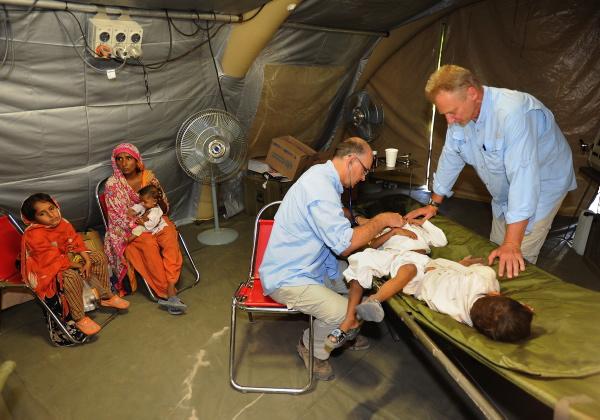From Bali to Sulawesi: the importance of northern Australia’s regional response capability
Posted By Len Notaras on February 25, 2019 @ 13:52

More than 16 years after the 2002 Bali bombings, Australia’s National Critical Care and Trauma Response Centre [1] (NCCTRC) in Darwin continues to demonstrate the importance of both geopolitical location and regional preparedness, particularly in the event of a natural or manmade disaster.
The NCCTRC is well situated at Australia’s natural gateway to Asia on the periphery of the notorious ‘Ring of Fire’. Before the centre’s establishment, Darwin and the Top End figured in a number of significant national events, none less than the first of many World War II bombings on 19 February 1942; the city’s levelling by Cyclone Tracy in 1974; and the unique strategic role of accommodating a ‘tent city’ following the 1999 Timor refugee evacuation.
The decision in 2002 to use Darwin and the Royal Darwin Hospital as the retrieval, rescue, resuscitation and then repatriation hub for the more than 75 Australians injured in the Bali terrorist attack was a strategic success. The north’s resilience and proximity have endured and continue to provide a regional soft-power lever in 2019.
The NCCTRC opened its doors in 2005 and has since evolved to become an important asset for enhancing Australia’s health security and disaster response capacity in the Top End. It is also active in building capacity and relationships across Asia and the Pacific. The NCCTRC provides a combination of readily adaptable and innovative response capabilities; training; teaching; exercising expertise; research initiatives; and mentoring and support for emerging medical teams across the Asia–Pacific.
The NCCTRC also works with the World Health Organization’s humanitarian and global outbreak divisions and plays a key role in the humanitarian aspects of Australia’s regional engagement.
Following the Haiti earthquake of 2010, a series of global standards for responding medical teams were developed on the NCCTRC site in collaboration with WHO. These standards are the benchmarks used by WHO across the world. Members of the NCCTRC assist with developing and mentoring other national teams across Asia and the Pacific, and further afield.
In 2016, the NCCTRC worked closely with WHO to achieve verification of Australia’s emergency medical assistance team, AUSMAT, as a WHO Emergency Medical Team Type 2 capability. AUSMAT is the official Australian government multidisciplinary healthcare team, which comprises doctors, nurses, paramedics, fire-fighters (logisticians) and allied health staff. These self-sufficient teams can be deployed in response to formal requests for assistance from a disaster-affected government. Australia’s AUSMAT was just the fifth team in the world to gain WHO certification.
The Australian government response to the devastating floods in Pakistan in August 2010 was the first time a large-scale joint civilian AUSMAT and defence team was deployed. The team—drawn from jurisdictions across the nation—was in the field for 11 weeks treating more than 11,000 patients. Australia’s response to the disaster has since been recognised as one of the most successful civil–military deployments.
The lessons from Pakistan shaped the AUSMAT and contributed to changes in global standards, with further refining occurring following the response to Typhoon Haiyan in the Philippines in 2013.
The tragedy of the Bali bombings in 2002 and 2005 has continued to provide an opportunity to galvanise the Darwin–Denpasar relationship, not just in disaster preparedness, but more broadly in clinical practice. An ongoing collaboration with the Sanglah Hospital—well supported by I Made Mangku Pastika, former governor of Bali—has enabled sharing of skills and knowledge with a focus on disaster preparedness and capacity building.
The NCCTRC continues to work with the Muhammadiyah Medical Group in Indonesia through an ongoing commitment following the 2018 tsunami and earthquake in Sulawesi.
Since 2009, with the development of a national AUSMAT capability, the NCCTRC has worked through federal, state and territory health services to ensure preparedness and participation of all jurisdictions and AUSMAT-trained clinicians.
A wider example of ‘soft power’ was well demonstrated in the strengthening of national relationships that followed the response to Cyclone Winston, which struck Fiji in February 2016.
Well before Winston, and as part of capacity and knowledge-sharing programs with regional partners, a small group of Fijian surgeons undertook AUSMAT training in Darwin. This not only raised both ability and awareness, but also lowered the threshold to seek ‘known’ and trusted support. Within hours of Winston’s making landfall, those surgeons deployed a rapid local surgical response to the disaster-affected areas and, with their encouragement, the Fijian government requested further AUSMAT assistance.
An Australian team worked closely with the Fijian government to identify and address areas of unmet need and provide support to the health system and their Fijian counterparts. At the conclusion of the AUSMAT response, the Fijian Ministry of Health and Medical Services (MoHMS) was provided with a report on the response to the disastrous cyclone. The review overwhelmingly reflected positively on the achievements of the health response in meeting the Fijian people’s immediate health needs and included additional recommendations on how key structures and coordination could be strengthened.
The NCCTRC has since developed a training package for emergency health responses in partnership with the MoHMS. This integrated education program will support the establishment of incident command and information management. It focuses on building the capacity of identified emergency health operations centres to address critical issues in a timely manner with available resources.
The partnerships forged through training and mentoring, and the sharing of exercising and educational modules, result in lives and limbs being saved and recovery occurring more quickly. When Tonga was struck by a severe cyclone in early 2018, it was satisfying to know that a well-prepared response could be quickly mounted locally and that additional support was unnecessary.
Article printed from The Strategist: https://aspistrategist.ru
URL to article: /from-bali-to-sulawesi-the-importance-of-northern-australias-regional-response-capability/
URLs in this post:
[1] National Critical Care and Trauma Response Centre: https://www.nationaltraumacentre.nt.gov.au/
Click here to print.